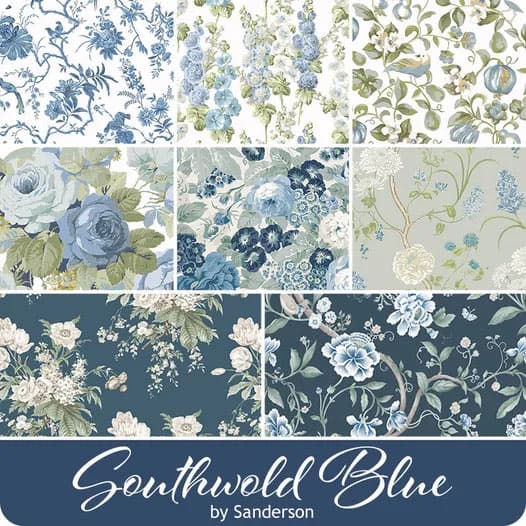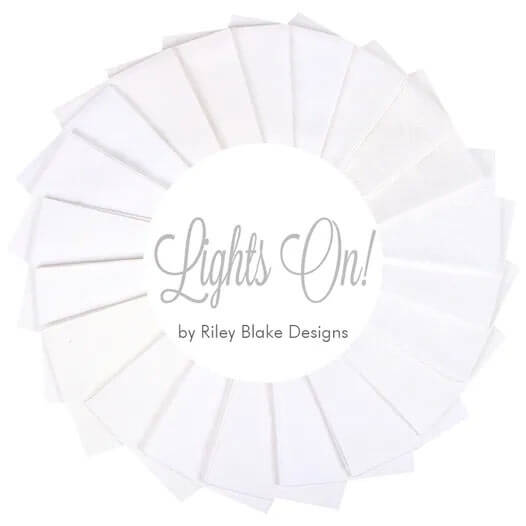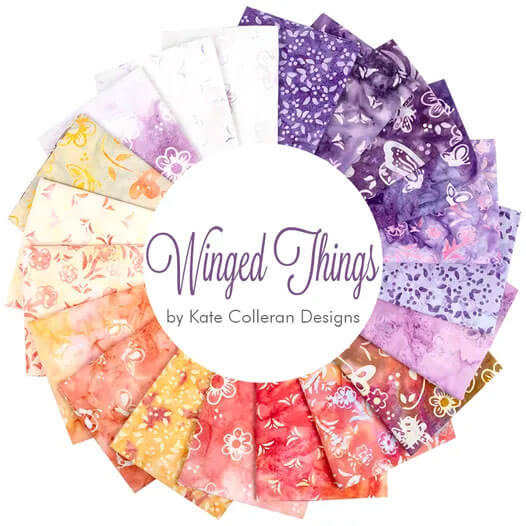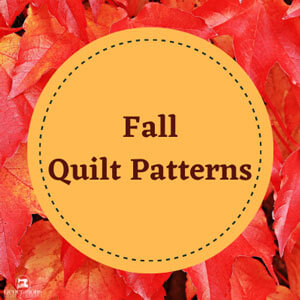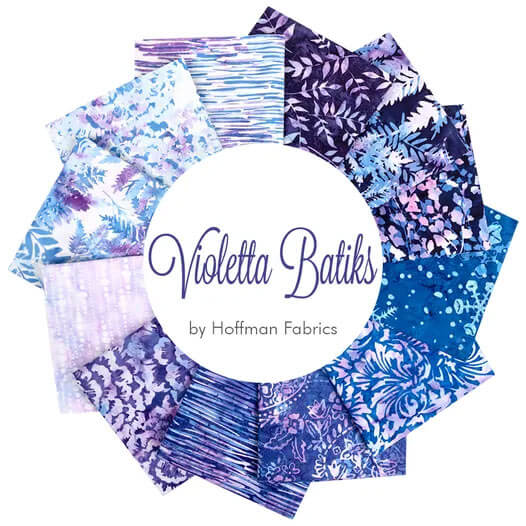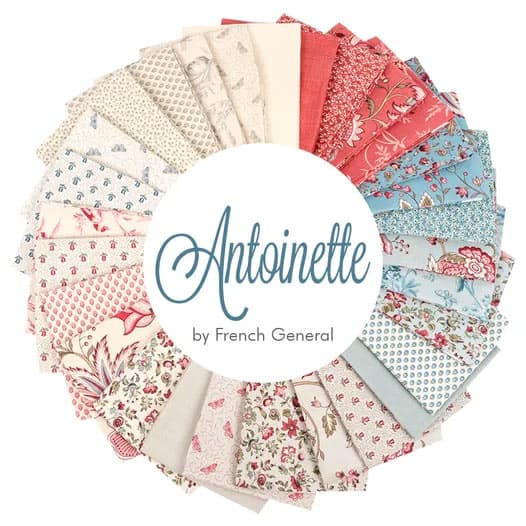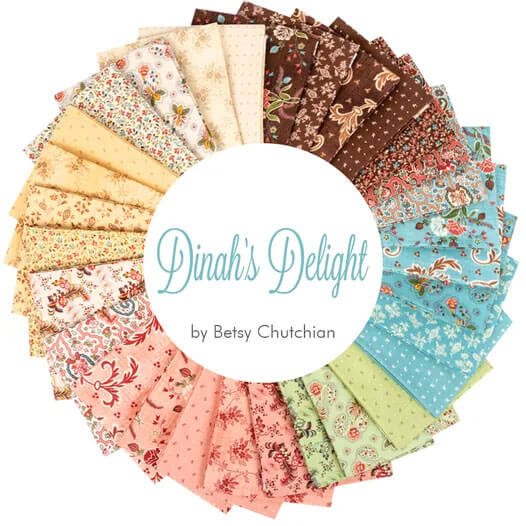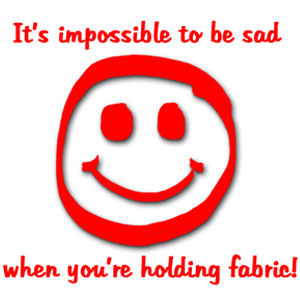- Home
- Free Quilt Block Patterns
- Churn Dash Quilt Block
Churn Dash Quilt Block
From our Free Quilt Block Patterns Library
This post contains affiliate links, for which I receive compensation.
Skill Level: Beginner
The
Churn Dash quilt block is fun to put together with just half square
triangles, simple strip pieced squares and solid squares.
It makes a great block for quilting bee and guild exchanges—quick to whip up at the last minute if needed—because of its simplicity.
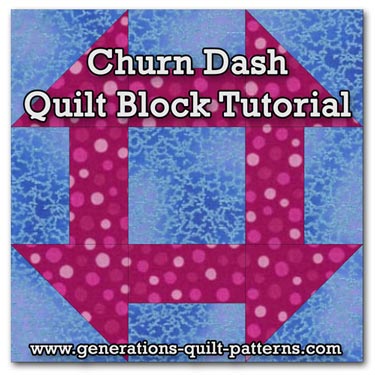
There are enough pieces in the block design to switch up the fabric placement and come up with radically different looking blocks.
This two fabric quilt block is known by a whole slew of other names. Do you recognize any of them? (Those underlined and blue are links to other tutorials on this website.)
|
Broken Plate |
Indian Hammer |
Picture Frame |
On this page you'll find instructions to make five different sizes, as well as seven common variations to add interest to your quilt projects.
When it's time to lay out your own finished Churn Dash quilt blocks visit Churn Dash Quilt Designs, part of our Quilt Design 101 series, for inspiration.
Time to start stitching!
General Instructions
These abbreviations are used in this tutorial:
- SA - seam allowance
- RST - right sides together
- HST - half square triangles
SA are 1/4" and pressed toward the darker fabric unless otherwise noted.
Pressing instructions are highlighted to make them easy to find.
When you are instructed to press, first press the pieced unit flat to set the seam.
Then open the patch, pressing from the front. Seam allowances are pressed to the dark fabric unless otherwise noted.
The newest quilt fabrics to tickle your fancy...
Click the images below to see the full collection. We share any commercial and/or free patterns that showcase them, too. (For inspiration, of course!)
Step 1: Cut patches for a Churn Dash
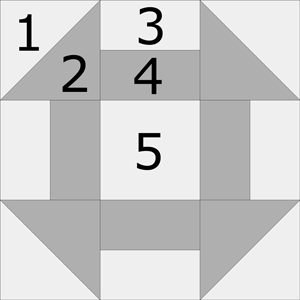 Churn Dash
Churn DashSample Block Size: 6" finished / 6½"" unfinished
Grid: 3x3
Attributed to: Ruby McKim
Design Type: Even 9-patch
Two fabrics and simple piecing are all it takes for this block.
I prefer to starch my fabric before cutting. I find that both my cutting and piecing are more accurate that way.
I cut my HST patches a bit bigger than the dimensions in the chart, stitch the units and then cut them to size.
Perfect HST every time!
 | Cutting Chart for a~Traditional Piecing ~ | ||||||
|---|---|---|---|---|---|---|---|
| Patch | Fabric | Qty | Finished Block Size | ||||
| 3" | 4½" | 6 " | 7½" | 9" | |||
| 1** | L | 2 | 1⅞" x 1⅞" | 2⅜" x 2⅜" | 2⅞" x 2⅞" | 3⅜" x 3⅜" | 3⅞" x 3⅞" |
| 2** | D | 2 | 1⅞" x 1⅞" | 2⅜" x 2⅜" | 2⅞" x 2⅞" | 3⅜" x 3⅜" | 3⅞" x 3⅞" |
| 3 | L | 1 | 1" x 7" | 1¼" x 9" | 1½" x 11" | 1¾" x 13" | 2" x 15" |
| 4 | D | 1 | 1" x 7" | 1¼" x 9" | 1½" x 11" | 1¾" x 13" | 2" x 15" |
| 5 | L | 1 | 1½" x 1½" | 2" x 2" | 2½" x 2½" | 3" x 3" | 3½" x 3½" |
| Unfinished Block Size | 3½" | 5" | 6½" | 8" | 9½" | ||
| Grid Size | 1" | 1½" | 2" | 2½" | 3" | ||
| **I prefer to cut my patches extra large for HST, stitch, and then trim them to size. If you prefer to do the same, add a bit extra to the measurements for Patches #1 and #2 above. There is a chart further down in these instructions where you need it for trimming them to size. | |||||||
These are the cut patches.
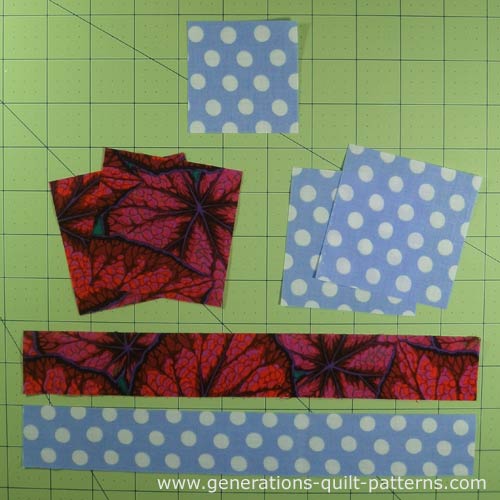
Step 2: Assemble the units
Half Square Triangle Units (HST)
We'll use the Quick Piece Technique for making HSTs.
Draw a diagonal line on the back of the 2-7/8" squares, dark enough so that you can see it.
With RST, align a light and a dark square and stitch a quarter inch away from the drawn line on both sides. Repeat for the second pair of squares.
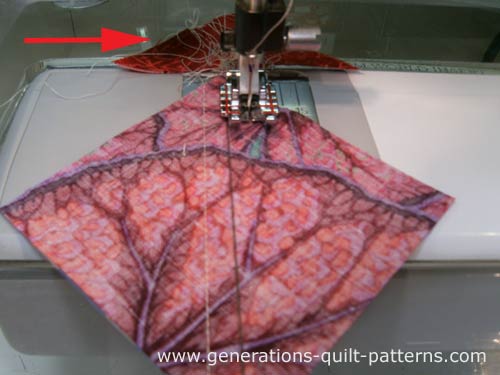 The arrow points to my anchor cloth
The arrow points to my anchor clothCut along the drawn line to create 4 HST units.
Press the units flat and then open with the seam allowance towards the dark fabric.
Use the table below to check the accuracy of your HSTs. Trim to size if needed.
For more detailed information on making Quick Pieced HSTs go to HST: Technique #1.
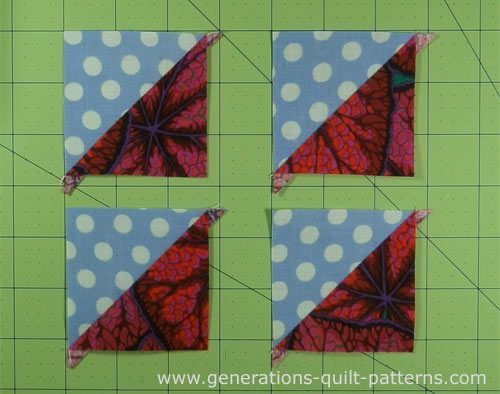 HSTs before trimming to size - need to get rid of those dog ears!
HSTs before trimming to size - need to get rid of those dog ears!Strip Sets
With RST, align the long edges of the light and dark 1-1/2" x 11" strip and stitch.
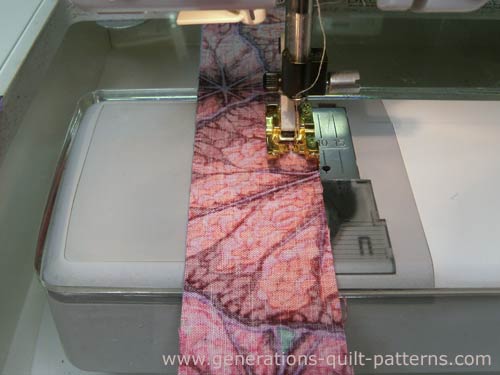 Stitch the strips together
Stitch the strips togetherPress the strip set flat and then with the SA towards the dark strip.
With your rotary cutter and ruler, straighten one end of the strip set.
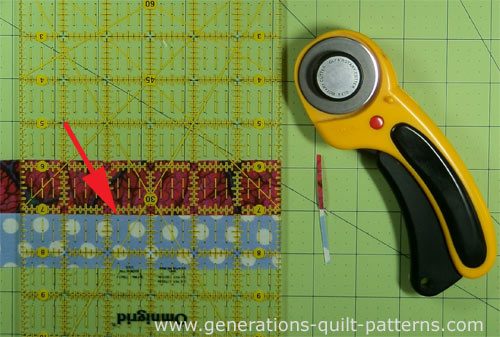 Align a straight line on the ruler with the seam line, and
Align a straight line on the ruler with the seam line, andcut off the uneven edge on one short side of the strip set.
Then cut four 2-1/2" squares from it.
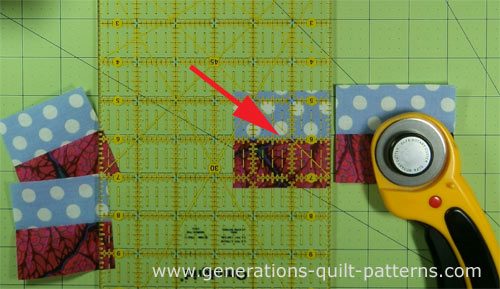 Again, align a straight on the ruler with the seam line before sub-cutting.
Again, align a straight on the ruler with the seam line before sub-cutting.Step 3: Assemble the Churn Dash quilt block
Lay out the HSTs, strip pieced units and solid squares into the Churn Dash design.
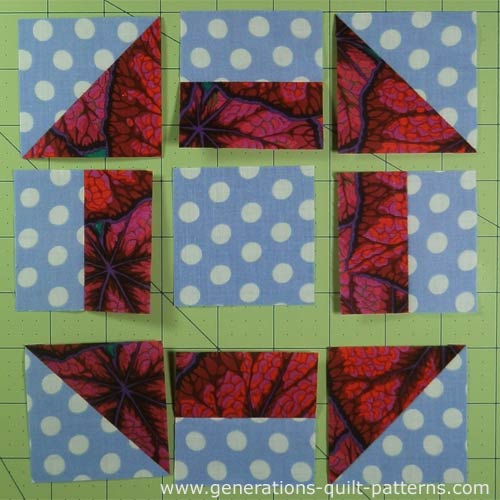
Stitch the units in each row together.
Press, with the seam allowances away from the HST so that your seam allowances nest. That makes matching easier.
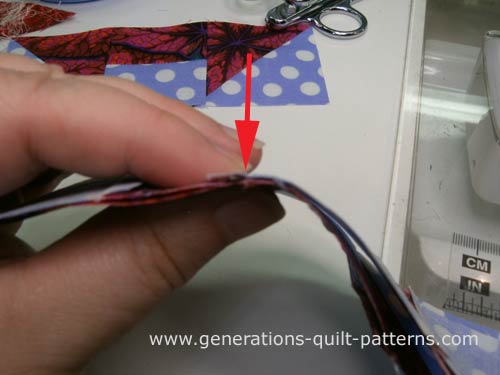
Stitch the rows together, pinning if needed.
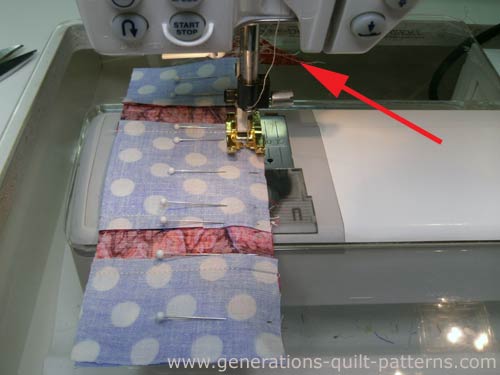 The arrow points to the anchor cloth
The arrow points to the anchor clothPress the seam allowances in the direction of the red arrows below.
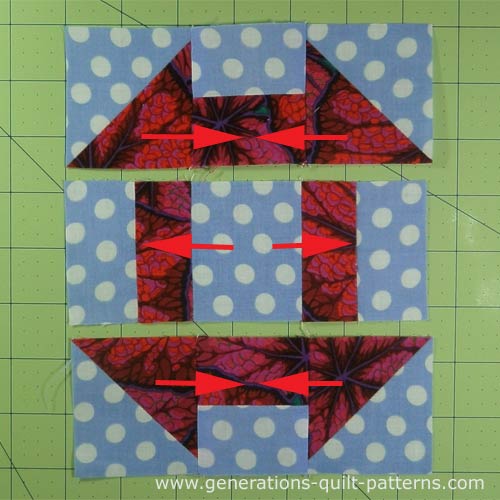
This is the finished Churn Dash quilt block.
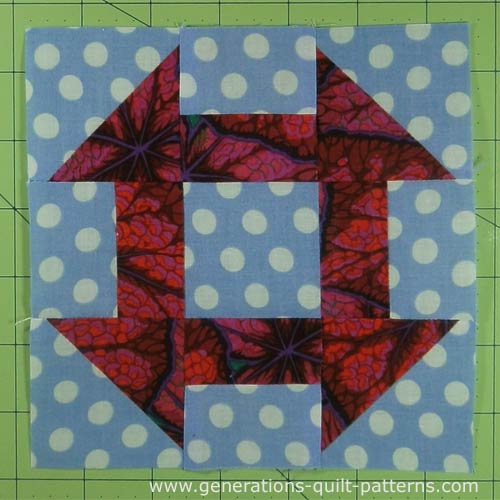
Variations on a Churn Dash design
There are several variations of the simple 3x3 Churn Dash quilt block.
All involve a change in the fabric placement. Many radically change the look of the block.
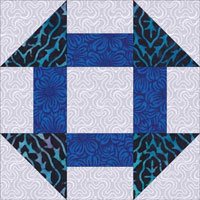
Churn Dash Variation
A 3 fabric version of the standard Churn Dash quilt block.
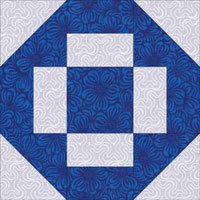
Greek Cross
A two fabric block with some swapping of the placements. A totally different look.
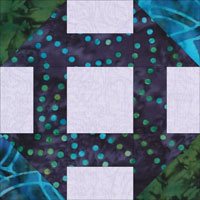
Dragon's Head
Two different fabrics are added to the original Churn Dash in the corners.
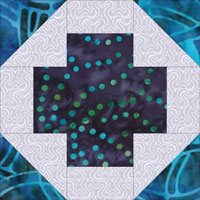
Grecian Design
This 3 fabric block looks nothing like the original, but all the design lines ARE there.
This version is also called: Grecian Square, Grecian or Greek Square.
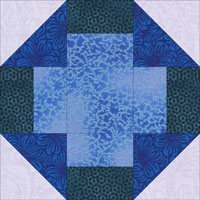
Mosaic
Add a fourth fabric and the block changes even more.
Then there are those that keep the same structure...
...but alter one of the elements.
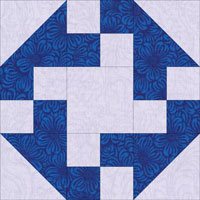
This quilt block has four patches instead of strip pieced squares in the center of each side. This small change adds a lot of movement to the block without increasing the difficulty.
Click here for instructions for this block.
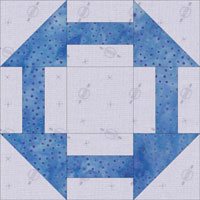
A third strip is added to the strip pieced squares creating a more delicate looking block.
For a rotary-cutter friendly block, make sure you choose a finished grid size that is easily divisible by 3.
Click here for instructions for this block.
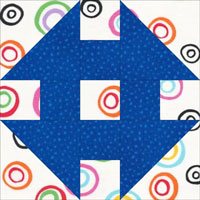
Monkey Wrench
In this last block, the Churn Dash design is drawn on a 5x5 grid (sometimes called an uneven 9-patch). The center and center side units are now a quarter the size of the HSTs.
Click here for instructions to make the Monkey Wrench quilt block.
Ready for More Blocks?

Blocks all finished?
Need a dash of inspiration?
Then sprint on over to our Free Quilt Block Pattern Library to find blocks for your next quilting creation!
What about a different quilt block?
For a list of all the 220+ quilt block patterns on this site, start here.
If you know the name of the block, shorten your search by using these links:
Click here if you're looking for blocks with at least some paper piecing.
Click here if you're looking for the basic building blocks of quilting, i.e., Flying Geese, half square triangles, quarter square triangles, etc., along with several techniques to make each.
And finally, use these links to find blocks in these finished sizes:
